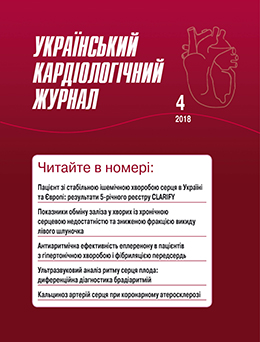Ultrasonоgraphic analysis of the fetal heart rhythm: clinical significance and differential diagnosis of bradyarrhythmias
Main Article Content
Abstract
The aim – 1) to evaluate the possibilities of ultrasound fetal heart examination in the detection and differential diagnosis of bradyarrhythmias; 2) to study the influence of arrhythmias on fetal hemodynamics; 3) to examine the role of fetal echocardiography in the management of prenatally diagnosed bradyarrhythmias for determining the optimal pregnancy and delivery tactics.
Material and methods. The analysis of echocardiographic examinations of the fetal heart from April 1996 to July 2016 has been performed. During this period 2073 pregnant women were examined and 213 cases of fetal heart arrhythmias were detected. Ultrasound examination of the fetal heart was conducted according to the general protocol. The anatomy of the fetal heart was assessed based on segmental analysis. Rhythm of the fetal heart was determined by simultaneous recording of mechanical events (contractions of the atria and ventricles), which are the consequence of electrical activity, with estimation of the ratio between them, as well as the measured time intervals of the cardiac cycle with calculation of their ratio. For this purpose, various ultrasound techniques (M-method, color, pulse-wave and tissue Doppler) have been used.
Results. During the study period 45 cases of fetal bradyarrhythmias were detected, (2.2 % of the number of all patients examined and 21.1 % of all arrhythmias). They included 20 cases (44.5 %) of periodic bradycardia of different duration, 9 cases (20 %) of sustained sinus bradycardia, 9 cases (20 %) of complete atrioventricular block, 5 cases (11 %) of blocked atrial bigeminy and 2 cases (4.5 %) of 2nd degree atrioventricular block. Persistent fetal bradycardia requires a complete echocardiographic examination to exclude structural pathology and assess possible hemodynamic complications. Bradyarrhythmias with a frequency of ventricular contractions of more than 60 bpm are well tolerated by the fetuses due to various adaptive mechanisms. Permanent forms of arrhythmia with a frequency less than 55 bpm, as usual, lead to serious hemodynamic comromise even in the absence of fetal congenital heart defects.
Conclusions. Ultrasound fetal heart examination provides not only the identification and reliable differential diagnosis of various types of fetal bradyarrhythmia, but also an assessment of its hemodynamic consequences and prenatal period monitoring of the fetal condition. This makes possible to choose the tactics of pregnancy management, determine the frequency of follow-up examinations, plan the time, place and route of delivery. The majority of fetal bradyarrhythmias are non-threatening rhythm disorders.
Article Details
Keywords:
References
Andelfinger G, Fouron JC, Sonesson SE, Proulx F. Reference values for time intervals between atrial and ventricular contractions of the fetal heart measured by two Doppler techniques. Am J Cardiol. 2001, Des 15; 88(12):1433–6.
Eliasson H, Wahren-Herlenius M, Sonesson SE. Mechanisms of fetal bradyarrhythmia: 65 cases in single center analyzed dy Doppler flow echocardiographic techniques. Ultrasound Obstet Gynecol. 2011 Feb; 37(2):172–8.
Glickstein JS, Buyon J, Friedman D. Pulse Doppler echocardiographic assessment of the fetal PR interval. Am J Cardiol. 2000 Jul 15; 86(2):236–9.
Hornberger LK, Sahn DJ. Rhythm abnormalities of the fetus. Heart. 2007 Oct;93(10):1294–1300.
Jaeggi ET, Hamilton RM, Silverman ED, Zamora SA, Hornberger LK. Outcome of children with fetal, neonatal or childhood diagnosis of isolated complete heart block. A single institution’s experience of 30 years. J Am Coll Cardiol. 2002 Jan 2;39(1):130–7.
Maeno Y, Rikitake N, Toyoda O, Kiyomatsu Y, Miyake T, Himeno W, Hirose A, Hori D, Kamura T, Kato H. Prenatal diagnoses of sustained bradycardia with 1:1 atrioventricular conduction. Ultrasound Obstet Gynecol. 2003 Mar; 21(3):234–8.
Manning N, Anthony JP, Östman‐Smith I, Snyder CS, Burch M. Prenatal diagnosis and successful preterm delivery of a fetus with long QT syndrome. Br J Obstet Gynecol. 2000;107:1049–1051.
Moak JP, Barron KS, Hougen TJ, Wiles HB, Balaji S, Sreeram N, Cohen MH, Nordenberg A, Van Hare GF, Friedman RA, Perez M, Cecchin F, Schneider DS, Nehgme RA, Buyon JP. Congenital heart block: development of late-onset cardiomyopathy, a previously underappreciated sequel. J Am Coll Cardiol. 2001 Jan;37(1):238–42.
Nield LE, Smallhorn JF, Benson LN, Hornberger LK, Silverman ED, Taylor GP, Mullen M, Brendan J. Endocardial fibroelastosis associated with maternal anti-Ro and anti-La antibodies in the absence of atrioventricular block. J Am Coll Cardiol. 2002 Aug;40(4):796–802.
Nield LE, Silverman ED, Taylor GP, Smallhorn JF, Mullen JB, Silverman NH, Finley JP, Law YM, Human DG, Seaward PG, Hamilton RM, Hornberger LK. Maternal anti-Ro and anti-La antibody associated endocardial fibroelastosis. Circulation. 2002 Feb 19;105(7):843–8.
Respondek-Libersra M. Bradykardie plodu. In book Kardiologia prenatalna. Wydawnictwo Czelej. 2006:125–130.
Schmidt KG. Fetal bradydysrhythmia. In book Fetal Cardiology (second edition) by Yagel S, Silverman NH, Gembruch U. Informa Helthcare 2009:449–460.
Sonesson SE, Acharya G. Hemodynamics in fetal arrhythmia. Acta Obstet Gynecol Scand. 2016 Jun; 95(6):697–709.
Tomek V, Marek J, Jicínská H, Skovránek J. Fetal Cardiology in the Czech Respublic: Current Management of Prenatally Diagnosed Congenital Heart Diseases and Arrhythmias. Physiol Res. 2009;58(Suppl 2):S159–66.
Van Praagh R. The segmental approach to diagnosis in congenital heart disease. Bith Defects. 1972;8:4–23.

